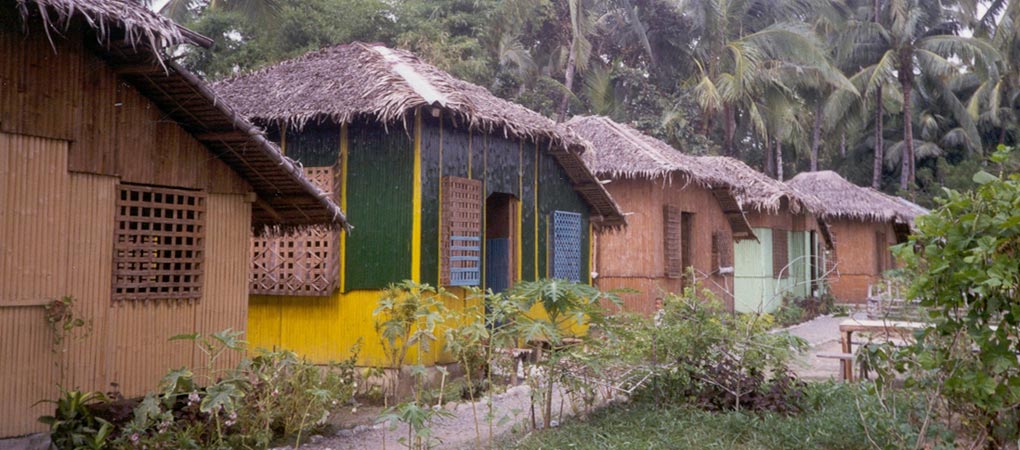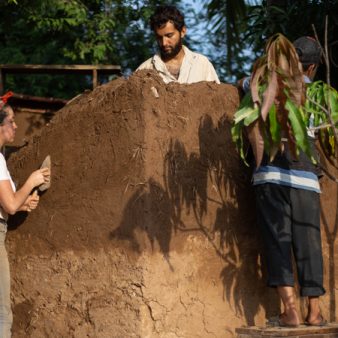After Typhoon Sisang in 1987, which completely destroyed over 200,000 homes, the Department of Social Welfare and Development (DSWD) of the Philippines government decided to instigate a programme of providing typhoon-resistant housing for those living in the most typhoon prone areas. Rather than use the international aid available to provide yet another temporary solution to the problem, the government decided to design a low-cost house which was resistant to typhoons which the people could build themselves using local materials. Only in this way could the cycle of devastation, which was such a limiting factor in the development of these lives and communities, be broken. The DSWD invited Professor Dr Satyendra P. Gupta of the highly experienced and respected Asian Disaster Preparedness Centre (ADPC) to advise.
The houses designed as a result are simple, inexpensive and made from a range of local materials. Poor people can, with technical guidance and the help of friends and neighbours, build the houses themselves. More recently built shelters have used more durable materials for the roof and wall panels. The wind resistant aspect of the houses is the crucial factor in their design and this ensures that the houses, whilst built using the same materials as previously, are no longer destroyed by strong winds. They are designed to withstand winds speeds of 180 kph and have been proven to do so.
To date, more than 28,770 such core shelters have been completed and none have been destroyed in subsequent typhoons. The programme is continuing throughout the Philippines. Provision of the actual dwellings is but one of the achievements of the project. An overall improvement in the lives of the families has been achieved through the related community development and income generation programmes. Families have higher incomes, are healthier, better educated and are taking responsibility for their lives where previously they relied on government assistance.
The key innovative aspect of the design is the strengthening of the structure to enable it to withstand typhoons. The Core Shelter technical design therefore has the following typhoon resistant features:
- Anchorage tying the roof to the ground through cement footings to achieve continuity.
- A four-sided roof design strengthened by roof trusses.
- Use of extra bracing and anchoring on wall and ceiling to ensure stability.
The shelter itself is quite small, measuring 3 m x 3.5 m. There are four wooden corner posts attached to concrete pedestals partially sunk in the ground and four wooden side posts, situated midway on each wall, similarly attached to concrete pedestals partially sunk in the ground. These firm footings, together with secure anchorage of the superstructure help to ensure that the dwelling remains firm during typhoons. Costs are kept down by using cheap, locally available materials for roofing, walling and flooring, since these units are not essential to the wind resistance of the dwelling.
Special wind resistance features are included in the dwelling to improve its wind resistance – these include wall and ceiling braces, anchor cleats and roof cross braces. Rafters are attached to the roof trusses and roof girt and additional steel strengthening is used at the corners where the hip rafters join the corner posts.
An essential aspect of the design is that it should be easy to understand and build. It is thus acceptable to local people who can be trained in the simple methods necessary and the technology can be easily transferred without the need for lengthy and complicated training courses. All aspects of house design and appearance, apart from the essential design aspects relating to wind resistance are left to the individual beneficiaries to develop as they wish. This results in a range of highly individual homes of which the families are justifiably proud.
Wherever possible shelters are built in a plot of 80 m2, enabling land around the shelter to be used for vegetable growing and other income-generating activities.
Each shelter requires a total of 47 man-days for its construction but with a small team of people the work can be scheduled into ten working days. Frequently the whole family will assist as general helpers. The completed frame of a dwelling can be seen below with the roofing work underway. Roofing and wall cladding take only one to two days, the bulk of the work being in the construction of the frame.
In addition to the basic Core Shelter dwelling, designs are available for three modules, or options, for upgrading the dwelling. This enables each family to have a basic Core Shelter which is typhoon-resistant, which they can then upgrade at a later date according to their resources and needs.
The community development programme that runs alongside the housing programme is a key aspect of the project, since the whole project aims not only to improve people’s shelter conditions but also other aspects of their daily lives. A range of health, education and income generation programmes run alongside the Core Shelter construction. Participation of the beneficiaries in the programme is considered crucial and the DSWD spends much time on the social preparation stage of a project, long before construction starts, in order that a strong community structure is in place.
Involving the beneficiaries in the project has several advantages. Firstly, it ensures that the type of shelter provided is exactly what the beneficiary wants and that needs are not exaggerated. Secondly, it guarantees the development of human capabilities and helps to avoid the creation of dependence. Thirdly, it generates a sense of pride and worth in the houses, which means the beneficiaries value and safeguard them to a greater extent than they would otherwise do. In addition, the provision of post-disaster shelter provides an opportunity to develop co-operative action and spirit.
A viable community organisation is required in order to mobilise resources, monitor the implementation of the project at the grass roots level and achieve a cost effective management and control over the resources used in the project. Meetings are held with municipal officials, mayors, priests, NGOs and community representatives and a community assembly is held to discuss the project and explain the practicalities of how it works. The responsibilities and commitments of those involved are explained.
Once beneficiaries have been identified for receiving assistance in the project, they are organised into groups of at least ten families called Neighbourhood Associations for Shelter Assistance (NASA). Regular meetings are held throughout the project. The beneficiaries receive training in construction methods and go on to build one unit of shelter under the guidance and help of a trained foreman, the other units in the group are then built with only limited supervision. Generally, one trained foreman is responsible for the construction of 30 Core Shelter units in co-operation with the beneficiaries and an area social worker. This has proved a highly workable and beneficial system of operation. It does however require a substantial commitment in terms of staff time at the beginning of each individual project, both from technical staff and social workers.
There is continuous monitoring of the work in progress to ensure the houses are being correctly constructed. The temptation is always to cut corners where possible, to use two nails instead of three, smaller timber than that specified and a vigilant watch is kept to ensure that construction is as specified. A certificate of completion is only given when the house is fully and properly completed. There is no better publicity for the project than when the core shelters are the only houses that remain standing and substantially undamaged after a typhoon has struck an area. A common experience is that villagers without Core Shelters will go to those of their friends and neighbours for protection in the event of a typhoon. The technology is also transferring to other families in the community who are not beneficiaries of the project – families who can afford to build their own homes are doing so incorporating the wind resistance features in their construction.
Funding for the basic core shelter comes from four basic sources – the beneficiary, local government, the DSWD (i.e. central government) and from NGOs. The DSWD contribution is in the form of a top-up contribution, meeting whatever cannot be found from the other sources and includes the salary of foremen and the purchase of carpentry tools, as well as the Food for Work element of the costs involved. The contribution of the beneficiary is assessed at the Needs Assessment stage early on in the project. This includes the provision of land, the labour of the beneficiary himself and his friends and relatives, any materials that he can obtain, either salvaged from the damaged house or from other sources plus a financial contribution if he has any savings. The local government is in a position to effectively address the land related problems, by providing resettlement areas for those who are landless and those high-risk communities who live by the sea-shore. The DSWD provides materials and technical assistance for the construction of concrete footings and wooden roof trusses. A beneficiary’s income may well be affected because of the time that he spends building the shelter and in this case a partial Food for Work assistance may be given. Emphasis is placed upon maximising the input of the beneficiary, not only so that the limited funds of the DSWD can be most effectively and extensively used, but also so that the commitment and involvement of the beneficiary is maximised.
Labour and the roofing and walling materials are the contribution to be made by the beneficiary. The major component of materials cost is the wood for the framing (55 per cent) with the foundation works (17 per cent) and the roofing and walling materials (18 per cent) the two remaining major cost items. The resettlement sites or individual home plots are provided either by local government or the NGOs.
The importance of providing poor families with a means of earning an income is an essential part of the DSWD integrated community development programme that it runs alongside the Core Shelter Programme. It enables the beneficiaries of the housing programme to earn additional income and brings all round improvements in the living standards of the community.
The minimum plot size of 80 m2 insisted on for all resettlement sites gives families an opportunity to develop small gardening enterprises, capable of feeding themselves as well as generating a marketable surplus. The process of learning how to build the Core Shelter teaches building and carpentry skills and a range of training courses are run in a variety of other skills. Many of these small enterprises, such as fish-farming, pineapple cultivation, mushroom cultivation, basket work and the production of building materials such as nipa wall panels are run by the women and children of the family as a supplement to the main source of family income.
Training is provided and small loans given to help families establish additional income generating activities and increase the family income. Fish ponds provide a valuable source of protein for the family as well as a source of income. Pineapple growing and wall panel weaving are also popular activities. Large plot sizes enable such activities to be carried out next to the house enabling the work to be done in conjunction with the daily domestic chores.
Partnership
National government, academic/research



